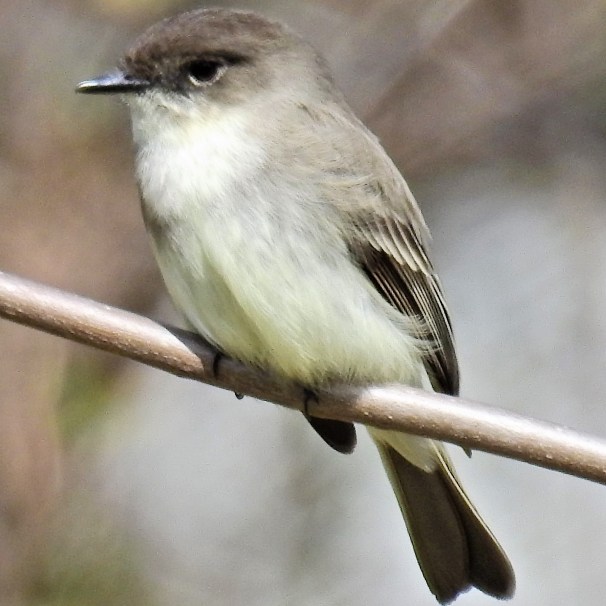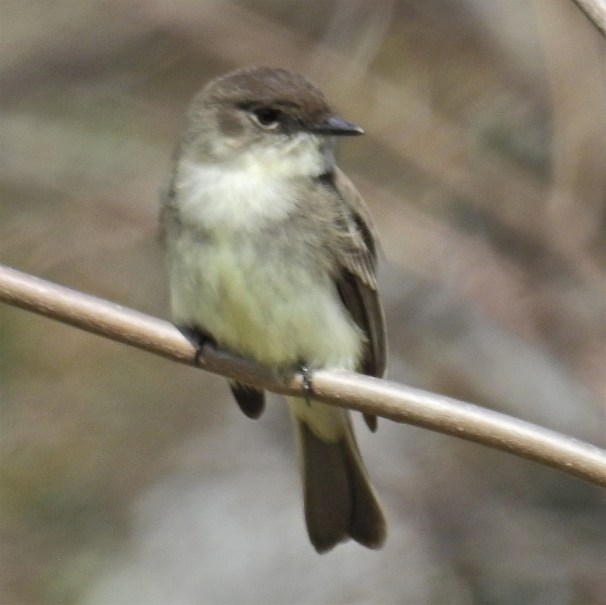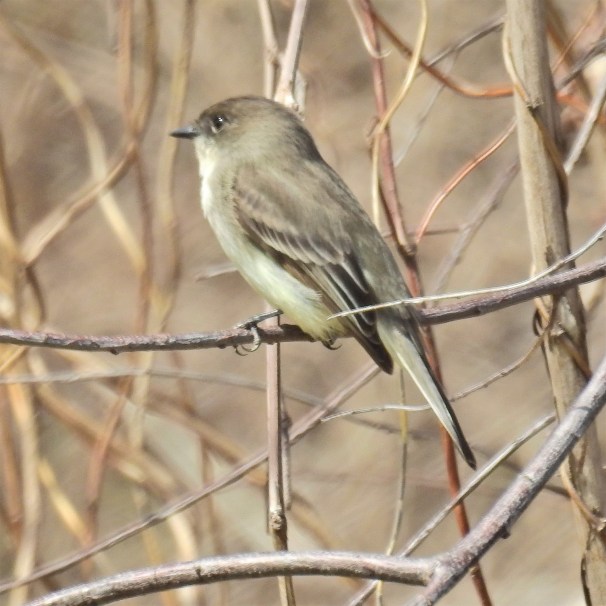
Eastern Phoebe
The Eastern Phoebe (Sayornis phoebe) is a small passerine bird. This tyrant flycatcher breeds in eastern North America, although its normal range does not include the southeastern coastal United States. It is migratory, wintering in the southernmost United States and Central America. It is a very rare vagrant to western Europe. This is one of the first birds to return to the breeding grounds in spring and one of the last to leave in the fall. They arrive for breeding in mid-late March, but they return to winter quarters around the same time when other migrant songbirds do, in September and early October; migration times have stayed the same in the last 100 years.
This species appears remarkably big-headed, especially if it puffs up the small crest. Its plumage is gray-brown above. It has a white throat, dirty gray breast and buffish underparts which become whiter during the breeding season. Two indistinct buff bars are present on each wing. Its lack of an eye ring and wing bars, and its all dark bill distinguish it from other North American tyrant flycatchers, and it pumps its tail up and down like other phoebes when perching on a branch. The Eastern Phoebe’s call is a sharp chip, and the song, from which it gets its name, is fee-bee. [Wikipedia]

Eastern Phoebe
One of our most familiar eastern flycatchers, the Eastern Phoebe’s raspy “phoebe” call is a frequent sound around yards and farms in spring and summer. These brown-and-white songbirds sit upright and wag their tails from prominent, low perches. They typically place their mud-and-grass nests in protected nooks on bridges, barns, and houses, which adds to the species’ familiarity to humans. Hardy birds, Eastern Phoebes winter farther north than most other flycatchers and are one of the earliest returning migrants in spring. [All About Birds]

Eastern Phoebe
Eastern Phoebe Facts [All About Birds]
- In 1804, the Eastern Phoebe became the first banded bird in North America. John James Audubon attached silvered thread to an Eastern Phoebe’s leg to track its return in successive years.
- The Eastern Phoebe is a loner, rarely coming in contact with other phoebes. Even members of a mated pair do not spend much time together. They may roost together early in pair formation, but even during egg laying the female frequently chases the male away from her.
- Unlike most birds, Eastern Phoebes often reuse nests in subsequent years—and sometimes Barn Swallows use them in between. In turn, Eastern Phoebes may renovate and use old American Robin or Barn Swallow nests themselves.
- The oldest known Eastern Phoebe was at least 10 years, 4 months old. It had been banded in Iowa in 1979 and was found in 1989 in Alberta.






as a child these were prevalent
LikeLike
Yeah? First time seeing one.
LikeLiked by 1 person
As kids we knew their call, of course, phoebe🎶
LikeLike
This bird is just on time for Easter,I am not sure it this bird yellow with a thouch of gray?? These birds just have a connection with you or you are just a naturally good @this…🌏🌏🌎
LikeLiked by 1 person
It’s gray and brown. Maybe the yellow you see is the sunlight. ☺
LikeLike
😊
LikeLike